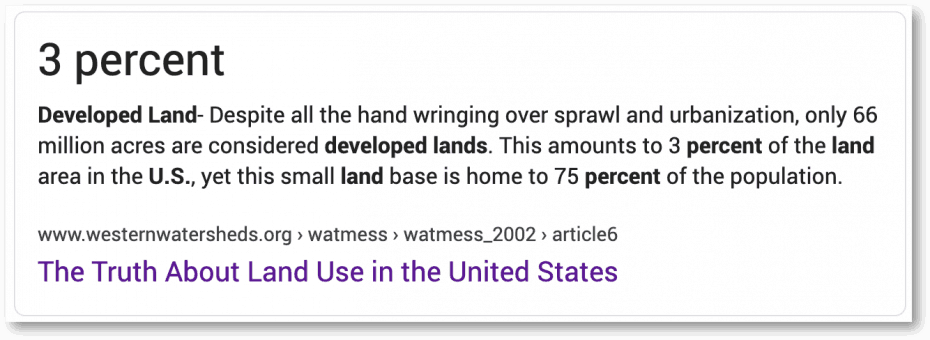Flipping vacant land is one of the most overlooked and misunderstood ways to make money in real estate.
It’s also one of the best.
I know this is a bold statement but when it comes to investing in real estate, I’ve been around the block.
I’ve worked for BiggerPockets, been involved in hundreds of house wholesaling transactions and interviewed some of the greatest minds real estate has to offer.
I also work full time for an incredible community at REtipster.com and, naturally, I’m always on the hunt for the next best thing in real estate, so our audience can benefit from it.
I’ve seen most of what’s out there there is simply nothing better than flipping vacant land.
What Do We Mean By “Flipping Land”?
Flipping land is a pretty simple concept.
Seth Williams has done a fantastic job explaining it in detail in this blog post, but at a high level, all you do when you flip vacant land is buy a parcel at 5-35% of market value and then turn around and sell it at a significant markup, usually 50% – 80% of market value.
That’s it!
As with everything, this business model is a lot easier said than done and I don’t want to make it sound like it’s push-button easy.
EVERYTHING worth doing takes a lot of work to accomplish.
Flipping land is really simple, and I’d make a case that it is, in fact, easier than most other real estate strategies.
Two Arms of the Land Business
There are two “arms” of the land business:
- The Buying Arm
- The Selling Arm
When you buy a property, there are essentially 5 steps to consider:
- Market Research
- Marketing (To Find Motivated Sellers)
- Lead Processing
- Due Diligence
- Closing
When you sell a property, there are only 3 steps to consider (maybe 4):
- Marketing (To Find Buyers)
- Lead Processing
- Closing
- Seller Financing Management (Optional)
7 Reasons Flipping Land Is Better Than Every Other Real Estate Strategy
There is a lot to unpack here!
Below I take the 7 major reasons why flipping land is better than every other real estate business model in existence – let’s dive into it!
1. The Returns Are Incredible
It’s not uncommon for an investor to make over 100% ROI in one land deal.
Frankly, that doesn’t exist in any other asset class in real estate.
In this quick video, I showcase one of my recent deals:
I bought this property for $5,200 all-in and 5 months later, sold it for $13,000.
After we factor in a 6% commission to my agent and closing costs, we walked away with $11,420.
If we put this into a simple ROI calculator, we’re looking at a 119.62% ROI.
This is an incredible ROI but, again, this is just a typical “base-hit” kind of a deal.
I routinely see returns like this and so do a lot of people in this business.
If you want to see what a “home-run” deal looks like, check out this case study by Seth Williams:
He bought a property for $500 and sold it for $25,000!
Yes, you read that correctly.
That’s a 4,900% ROI!
It’s INSANE what’s possible in the land flipping business!
2. Deals Are (Relatively) Easy To Find
One of the hardest things in real estate investing is finding deals on a reliable, consistent basis.
The thing with land flipping, however, is that finding deals is the easy part – the bottleneck of the business is in selling properties (more on this in a minute).
When I used to work for a large wholesale operation out of Indianapolis, IN we used to spend tens of thousands of dollars in direct mail marketing, EVERY SINGLE MONTH.
In addition to this, we still had to use online advertising, work with other wholesalers and a number of other strategies to try and get deals.
It was A LOT to handle!
In contrast, with land flipping, it’s considered spending BIG money if you drop more than $2,000 on a single direct mail campaign.
In my business, I see 1-2 deals per every thousand letters I send.
As crazy as it sounds, it’s like clockwork. As long as I have mail out there, I’m getting deals. It’s just that simple!
RELATED: 8 Land Investing Myths Debunked
3. Deals Are WAY Cheaper To Fund
Another big pain point in real estate investing is determining how you’re going to finance your operation.
Going back to my wholesaling days – Indianapolis is generally considered an inexpensive market.
On average, we bought properties between $15,000 – $35,000, per deal.
Even at these kinds of prices, there are still a lot of costs to figure out.
If we use $15,000 as our example, and say we buy 10 deals, that’s $150,000 in acquisition costs alone!
Most land flippers are buying properties between $1,000 – $5,000 each, so as you can see, it’s a lot more affordable!
4. There is Very Little Competition
I recently attended a real estate meetup in Chicago, IL. Out of 60-80 people, I was the only person doing the land business.
There were several wholesalers, rehabbers and buy & hold investors in attendance, but no one else flipping land.
This is the story almost every time I attend a real estate networking event. I’m normally a lone wolf in the crowd, and I get funny looks when I tell people what I do.
Most people haven’t even heard of this model of land investing and they don’t understand how someone could make legitimate money from it.
When it comes to buying and selling property, because you can essentially do this business anywhere, it’s rare to run into other land flippers targeting the same leads as you.
In fact, for most land flippers, they look at the presence of other competitors targeting the same area as a good thing.
In the land business, competition simply validates that the market is producing results.
This was not the case when I worked as a house wholesaler – the more people that started wholesaling houses in Indianapolis, the harder and harder it became to get deals.
People might say that, in theory, if more people begin flipping land then eventually this would happen to the land industry as well…
But it’s not the case.
For land flippers, our market is pretty much the entire nation, whereas, most other real estate investors are tied to a particular city.
The bottom line is, if your allotted amount of potential deals is limited to one or two metropolitan areas, there is an inherent cap on how much business you can do.
In contrast, when we look at undeveloped land, the threshold to support other investors is simply so much higher.
If you do a Google search for “what percentage of U.S. land is developed” you’ll see the top result says 3% – that means 97% of the land in the United States is UNDEVELOPED! (source)
Say there is 2.43 billion acres of land in America (source), with only 3% of that land 0considered developed. Let’s do some math here.
2,430,000,000 acres * 0.97 = 2,357,100,000
That leaves us with well over 2.3 billion acres.
Let’s be ultra-conservative and say only 0.50% – not even 1 measly percentage of this total acreage is available for land flipping.
Even with this ridiculous number, our threshold of potential deals would be 11,785,500!
2,357,100,000 * 0.005 = 11,785,500
The point I'm trying to make is that in contrast to houses, it’s more likely that a much larger amount than 0.50% of undeveloped land is suitable for investment purposes… with houses making up only a small percentage of the total housing units that could be distressed or suitable for investment purposes at any given time, due to the fact that the majority of houses are lived in and maintained by people.
As you can see, when we run the numbers, the land business can handle far more competition than any other type of real estate investing.
5. It’s Strongly Protected Against Recession
Unlike almost every other type of real estate, the land business doesn’t really stop if the economy bottoms out.
Due to the fact that we’re able to buy properties so inexpensively from the masses of motivated sellers around the country, even in light of a recession, we’d most likely be able to sell our properties for around what we bought them for.
This would enable us to get our capital out and then reinvest at the adjusted market rate, based on the lower property values in a recession.
Due to the hard times that typically accompany recessions, people will be even more motivated to sell than normal, which translates to better and better deals.
Even if for some odd reason, we weren’t able to get our principal out, due to our ability to sell land through seller financing, we could still turn a HUGE profit just by offering terms instead of demanding cash (say $100 down, $100 per month).
RELATED: Why Seller Financing Makes Sense
Any way you look at it, it’s a lot safer than every other type of real estate, even during a recession – you just have to make sure you buy at the right price!
6. It Can Generate Cash Flow (If You Want)
Continuing the conversation about seller-financing, in the land business, you have a lot of options on how you can sell your property.
It’s very common for a land flipper to make over 100% ROI just in the sale price alone, and then make an additional 15% interest per year on top.
It’s also common for them to get 80-100% of their principal out in the down payment!
It’s Insane! Nothing else can touch the land business!
And what’s even crazier, is that if you structure the terms of each deal properly, even if a buyer defaults on you, it’s not the end of the world… you can just assume control of the property and resell it.
7. You Can Avoid The Three T’s of Real Estate: Tenants, Termites and Toilets!
Every problem in real estate investing can boil down to tenants, termites and toilets.
When you're dealing with land, you don’t have ANY of these problems.
As long as you've got the right deal, at the right price… all you need to worry about is selling it.
That’s it!
The Two Major Drawbacks of Flipping Land
Of course, everything in life has pros and cons and the land business is no exception.
We’ve just covered the pros, so let’s cover some of the cons.
1. This is an Active Business, Not a Passive Investment
I like to divide the world of real estate investing into two camps: real estate businesses (active) and real estate investments (passive).
Real estate businesses require that you work. If you stop working, you stop making money.
Things like rehabbing houses, wholesaling, being a broker, etc. are all strategies of real estate investing that require you to be “active”.
Land flipping falls squarely into this category as well.
You have to make sure mail goes out, leads are processed, and that you’re actively selling properties. If you don’t, you simply won’t make money.
Even with seller-financed deals that produce monthly cash flow, these sources of cash flow won't last forever. At some point, you have to keep buying more properties in order to keep the money coming in.
On the other hand, when it comes to real estate investments, these are much more passive in nature.
Private lending, buy and hold, triple net, etc. – once these deals are secured and set up properly, they take very minimal effort to maintain.
There are pros and cons to each, but land is by no means a passive endeavor.
If your goal is to buy an asset that makes money all on its own, land probably isn’t for you.
2. Deals Are Easy To Find, But Tough To Sell
As I mentioned earlier, the biggest bottleneck in the land business is in selling property.
You will spend the bulk of your time and effort in finding buyers and getting properties sold.
There are a number of things you can do to help make this happen, however, things just take a little longer to sell.
RELATED: 5 Fundamentals That Sell Real Estate Fast
I’m typically selling properties within 3-6 months after taking ownership.
When I was wholesaling, we would panic if we held onto a property longer than 3 months.
The turnaround time with land is similar to flipping houses, but without the headaches of having to conduct a full rehab.
So, if land is something that interests you, be ready to hold onto properties a little while and put the hustle on!
The Next Steps
As we wrap things up, I’m sure you have a lot of questions.
Below are links and resources to help you take your next steps, and to address some of the more questions that you may have.
Flipping vacant land has radically changed my life and I hope that this blog post is the catalyst that changes yours…










